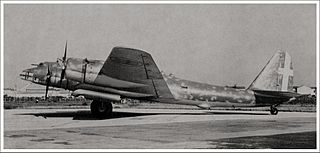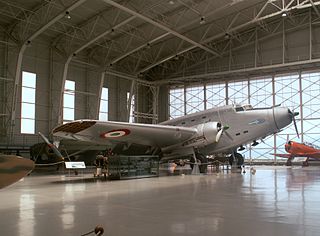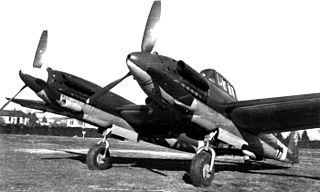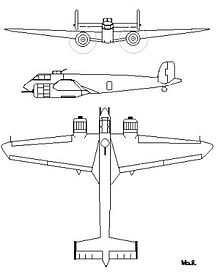Development
The SM.89 was intended to be a bomber/attack aircraft, something similar to Junkers Ju 88. The aircraft displayed some impressive features, but it was not a new project, rather an extrapolation from the earlier SM.84. The project utilized the wings, the aft fuselage and the mixed construction of the latter almost untouched, with a totally redesigned nose. The fuselage was made from a skeleton of steel tubes, covered with duralumin and wood back as far as the dorsal turret, the remainder of the fuselage being of wood and fabric construction. The wing was made of wood using three spars and a covering of compensate wood. The control surfaces comprised slats and flaps, and the ailerons, that were lowered partially with the flaps to increase lift.
The forward fuselage was the real difference between the SM.84 and SM.89. The forward fuselage housed only one pilot, after him there was a radio operator/gunner, and finally a gunner. Therefore, the aircraft had only half a crew, compared to the S.84. The fuselage was much more cramped than the S.84's, this was also due to the tandem position for all the crew, because a smaller crew area meant that less protection was needed.
The aircraft did not have a nose engine, unlike many contemporary Italian designs. The SM.89 was a two-engine aircraft so that the nose could be used to house weapons. The nose section was rounded, short, and inclined sharply to provide good visibility for attacks on surface targets. The weaponry was mainly based on the 37 mm (1.46 in) Breda anti-aircraft guns, used in the anti-tank and anti-ship roles. Three 12.7 mm (.50 in) Breda machine guns were also fitted in the nose. A further Breda machine gun was also fitted in the dorsal turret, and another was in a new model turret, a remote-controlled one, in the ventral position.
The aircraft could carry 700 bomblets or 1,400 kg (3,090 lb) of bombs or torpedoes under the belly. The aircraft could also be fitted with air brakes for dive bombing. The aircraft's speed also made it possible to use the aircraft as a bomber interceptor, however it was never fitted with a radar.
The Piaggio P.XI engines were too weak for the aircraft, so instead, two Piaggio P.XII RC.35 were used. These could develop 1,119 kW (1,500 hp) at take-off. These engines were in a more compact installation than those of the Piaggio P.108s and CANT Z.1018s. The aircraft could also carry 2,700 L (710 US gal) of fuel in self-sealing fuel tanks, which gave the aircraft an effective range of 720 km (450 mi).
The SM.89 had very heavy armour protection. The armour for the front and windscreen totalled 300 kg (660 lb), another 300 kg (660 lb) of armour protected the engines, and a further 80 kg (180 lb) was used in the aft armour. The aircraft was also possibly equipped with a CO² fire extinguisher system.
Operational service
The aircraft flew in 1941, but it was not until September 1942 that it was sent to Guidonia for evaluation tests. The aircraft was taken into use in March 1943, seeing service in the anti-tank and other roles. The results were quite good, with its firepower second only to the P.108A.
The real problem with the S.89 was the power and the reliability of the engines. 2,237 kW (3,000 hp) was not enough for the 12,600 kg (27,780 lb) aircraft. It was planned to install Piaggio P.XV or Alfa Romeo 135 engines on the aircraft, but this never took place.
The pilots found the aircraft to be difficult to fly, nose heavy, not maneuverable enough, too slow, and difficult to land. During flight, the aircraft needed to have an elevated angle of attack so as not to lose altitude. The aircraft was later forgotten and sent to Foligno in July 1943. It was captured by the Germans after 8 September 1943 and vanished.
The aircraft could possibly have been more successful had it carried less weapons or armour. Both combined caused the weight to surpass 12,000 kg (26,460 lb). The attempt to cover both the attack and even interception requirements made this aircraft even less reliable and flyable than the already mediocre S.84.

The Savoia-Marchetti SM.79 Sparviero was a three-engined Italian medium bomber developed and manufactured by aviation company Savoia-Marchetti. It may be the best-known Italian aeroplane of the Second World War. The SM.79 was easily recognizable due to its fuselage's distinctive dorsal "hump", and was reportedly well liked by its crews, who nicknamed it il gobbo maledetto.

The Savoia-Marchetti SM.81 Pipistrello was the first three-engine bomber/transport aircraft serving in the Italian Regia Aeronautica. When it appeared in 1935, it represented a real step ahead in Italian military aviation: it was fast, well armed and had a long range. It proved effective during the war with Ethiopia and the Spanish Civil War. Despite being too slow to remain competitive as a bomber in the later years of World War II, it was one of the most flexible, reliable and important aircraft of the Regia Aeronautica from 1935 to 1944, and adapted to second-line duties in a wide range of tasks.

The Fiat BR.20 Cicogna was a low-wing twin-engine medium bomber that was developed and manufactured by Italian aircraft company Fiat. It holds the distinction of being the first all-metal Italian bomber to enter service; at the time, it was regarded as one of the most modern medium bombers in the world.

The Piaggio P.108 Bombardiere was an Italian four-engine heavy bomber that saw service with the Regia Aeronautica during World War II. The prototype first flew on 24 November 1939 and it entered service in 1941. It was one of a handful of Italian combat aircraft that could match the best manufactured by the Allies. Four versions of the P.108 were designed, but only one, the P.108B bomber, was produced in any quantity before the armistice. The other variants included the P.108A anti-ship aircraft with a 102 mm (4 in) gun, the P.108C, an airliner with an extended wingspan and re-modelled fuselage capable of carrying 32 passengers, and the P.108T transport version designed specifically for military use. Only one P.108A and 24 P.108Bs were built. The combined total number of all versions was at least 39, almost certainly more than 44. Most of the P.108Cs were subsequently modified for use as military transport aircraft and could accommodate up to sixty passengers. Nine P.108 Ts were used by Luftwaffe transport units until the end of the war.

The Breda Ba.88 Lince ("Lynx") was a ground-attack aircraft used by the Italian Regia Aeronautica during World War II. Its streamlined design and retractable undercarriage were advanced for the time, and after its debut in 1937 the aircraft established several world speed records. However, when military equipment was installed on production examples, problems of instability developed and the aeroplane's general performance deteriorated. Eventually its operational career was cut short, and the remaining Ba.88 airframes were used as fixed installations on airfields to mislead enemy reconnaissance. It represented, perhaps, the most remarkable failure of any operational aircraft to see service in World War II.

The CANT Z.1007 Alcione (Kingfisher) was an Italian three-engined medium bomber, with wooden structure. Designed by Filippo Zappata, who also designed the CANT Z.506 it had "excellent flying characteristics and good stability" and was regarded by some as "the best Italian bomber of World War II" although its wooden structure was easily damaged by the climate, as experienced in North Africa and in Russia. It was used by the Italian Regia Aeronautica, Italian Co-Belligerent Air Force, Aeronautica Nazionale Repubblicana and Luftwaffe during World War II.

The Savoia-Marchetti SM.82 Marsupiale was an Italian bomber and transport aircraft of World War II. It was a cantilever, mid-wing monoplane trimotor with a retractable, tailwheel undercarriage. There were 875 built, the first entering service in 1940. Although able to operate as a bomber with a maximum bombload of up to 8,818 lb (4000 kg), the SM.82 saw very limited use in this role. The SM.82 was the foreign aircraft used in largest number by the Luftwaffe, which operated several hundreds of this aircraft, as a transport. Post-war about 30 SM.82s continued in service with the Aeronautica Militare Italiana, many remaining in service until the early 1960s.

The Savoia-Marchetti SM.75 Marsupiale was an Italian passenger and military transport aircraft of the 1930s and 1940s. It was a low-wing, trimotor monoplane of mixed metal and wood construction with a retractable tailwheel undercarriage. It was the last of a line of transport aeroplanes that Alessandro Marchetti began designing in the early 1930s. The SM.75 was fast, robust, capable of long-range flight and could carry up to 24 passengers for 1,000 miles.

The Savoia-Marchetti SM.85 was an Italian monoplane dive bomber and ground-attack aircraft that served in small numbers in the Regia Aeronautica at the beginning of World War II. They were soon replaced in service by the Junkers Ju 87.

The CRDA CANT Z.1018 Leone (Lion) was an Italian medium bomber of the 1940s.

The Caproni Ca.135 was an Italian medium bomber designed in Bergamo in Italy by Cesare Pallavicino. It flew for the first time in 1935, and entered service with the Peruvian Air Force in 1937, and with the Regia Aeronautica in January 1938.

The Savoia-Marchetti SM.84, not to be confused with the Savoia-Marchetti S.84 airliner prototype, was an Italian bomber aircraft of World War II. It was designed by Savoia-Marchetti as a replacement for its successful SM.79, and shared its three-engine layout. Despite entering service with the Regia Aeronautica in 1941, it was retired from service before the SM.79 and never fully replaced it.
The Savoia-Marchetti SM.88, was an Italian twin-engined, three-seat, heavy fighter prototype of World War II, featuring a twin-boom structure, and powered by German Daimler-Benz DB 601 engines.

The Savoia-Marchetti SM.91 was a two-seat, twin-engined, Italian heavy fighter prototype, designed to compete in a 1942 revision to a long-range fighter-bomber contract offered by the Regia Aeronautica to Italian aircraft companies in 1938. The original 1938 specification yielded the Savoia-Marchetti SM.88, which the SM.91 was largely based on.

The Savoia-Marchetti SM.92 was an Italian heavy fighter/bomber of World War II based on the Savoia-Marchetti SM.88. The SM.92 did away with the mid-wing crew nacelle. The crew of two sat in the left fuselage only. Two DB 605 engines were fitted.

The Savoia-Marchetti SM.78 was an Italian bomber/reconnaissance biplane flying boat of the early 1930s.

The Breda Ba.201 was an Italian dive bomber designed during World War II, that never entered production.

The Piaggio P.119 was an Italian experimental fighter of World War II. It had a relatively novel layout, with a "buried" radial engine mounted mid-fuselage. Only a single prototype was built before the Armistice between Italy and the allied armed forces, which ended the project.
The Piaggio P.32 was an Italian medium bomber of the late 1930s, produced by Piaggio, and designed by Giovanni Pegna. It was a modern design for its time, but was a failure due to lack of powerplants commensurate with its high wing loading.

The CANSA FC.20 was a twin engine reconnaissance bomber/ground attack monoplane designed and built in Italy in 1941. Several versions with different armament and engines were flown but only the FC.20bis ground attack variant reached squadron service, in very small numbers, before the 1943 armistice.



















